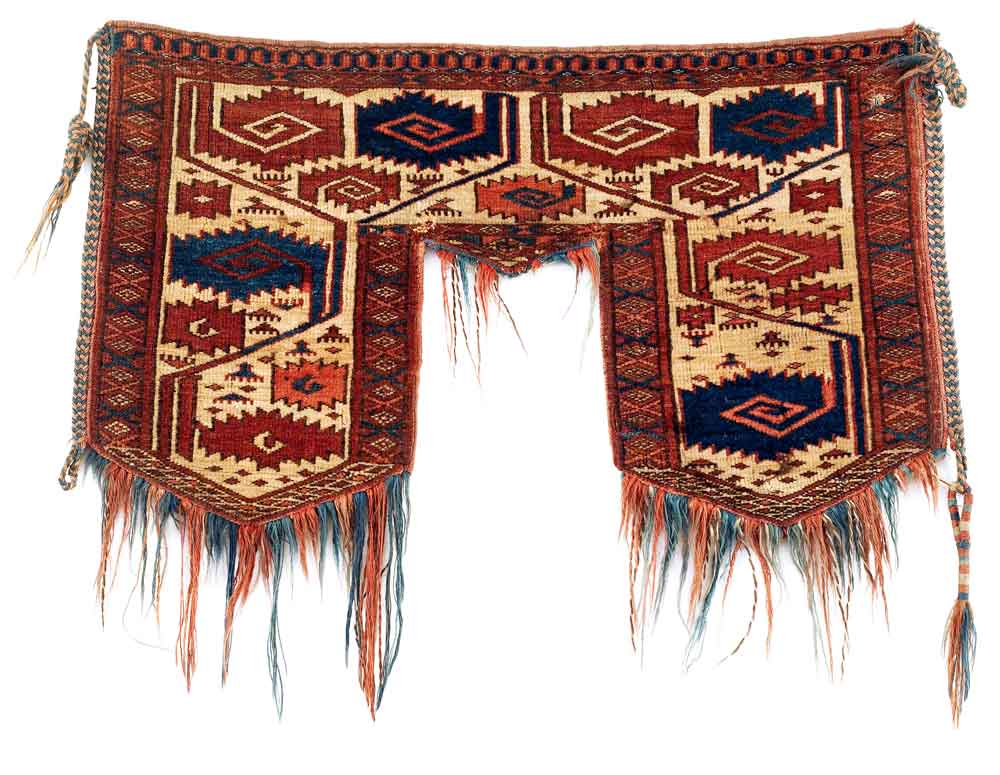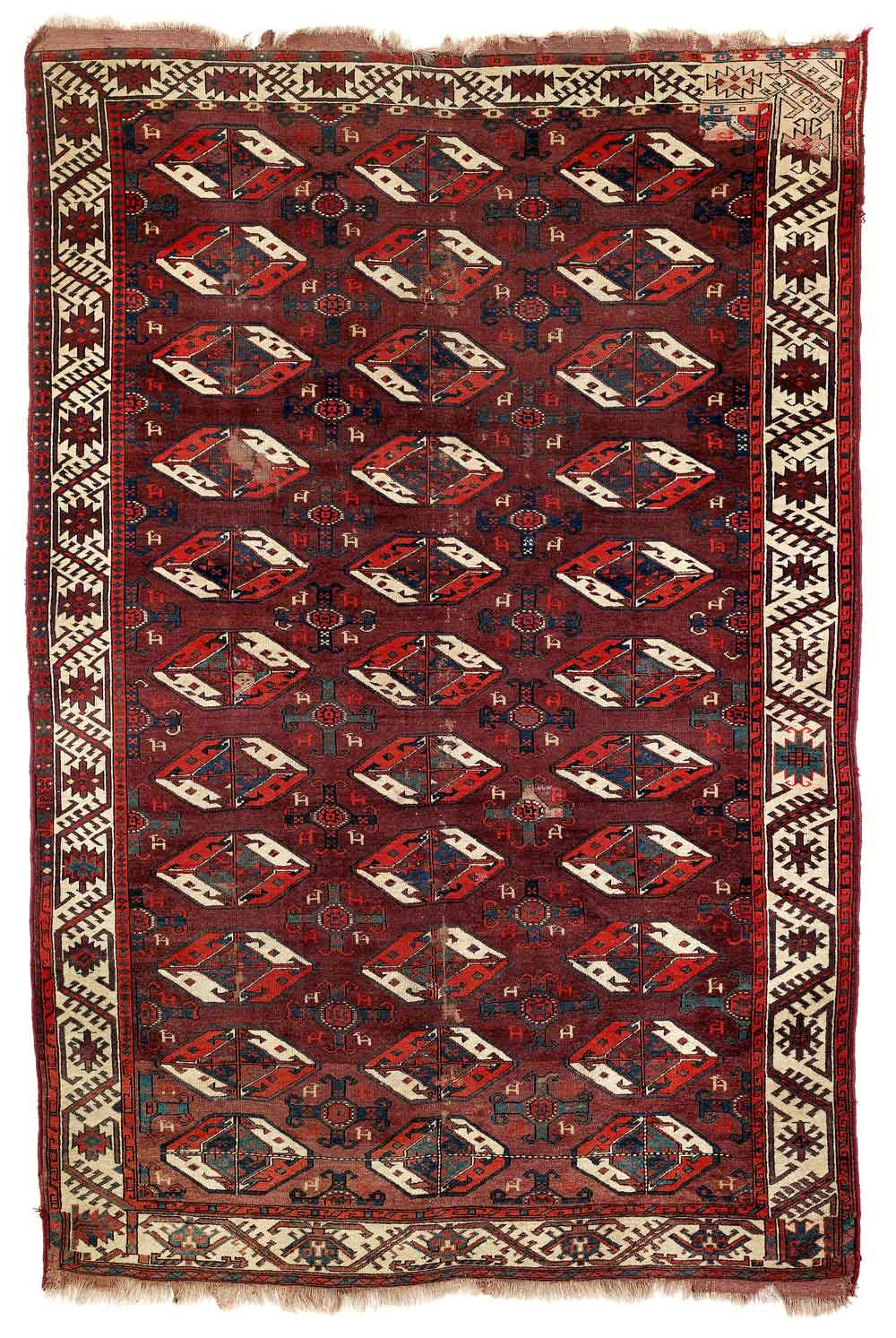Turkmens rule the roost at Rippon Boswell
In Rippon Boswell’s ‘Major Spring Auction‘ of antique carpets, kilims, embroidered textiles and carpet books on 31 May 2014, about 55% of the 243 lots sold for a gross value, including 22% premiums, of close to three quarters of a million Euros (about $1 million). Both the sold percentage and the total yield will rise during the course of the next four weeks with aftersales.
In terms of headlines, the sale was dominated by half a dozen good/important/beautiful Turkmen weavings, which together accounted for almost half of the total yield. Leading the pack was the much discussed cover piece, lot 96, the beautiful three and a half niche fragment of a vast ‘Bukhara’ saf or multiple-niche mosque prayer carpet, reputed to have been made for the Great Mosque in Bukhara and dismembered and distributed among the populace after the Bolshevik Revolution. Estimated at €65,000, it sold to an Italian buyer in the room, who jump-bid the hammer price from €70,000 to €100,000 (€122,000/$165,920 with premiums), thereby knocking at least two Transatlantic telephone bidders out of the race.

‘Bukhara’ Turkmen saf fragment, Uzbekistan, 19th century. Rippon Boswell, Wiesbaden, 31 May 2014, lot 96. Estimate €65,000, sold for €122,000 ($165,920)
Next of the Turkmens was lot 127, a rare Tekke (?) khalyk or camel breast trapping with a curled-leaf design, the first of a small group of pieces consigned by George Bailey, formerly a consultant of many years standing to Christie’s in New York. The khalyk, previously published in 1980 by Pinner and Franses in Turkoman Studies I (1980), was sold against an estimate of €10,000 to a Californian collector for €30,500 ($41,480), almost double the highest price on record for an example at auction, also at RB in 2007 (HALI 152, p.126).

The Bailey Tekke (?) Turkmen khalyk, 19th century. Rippon Boswell, Wiesbaden, 31 May 2014, lot 127. Estimate €10,000, sold for €30,500 ($41,480)
This was followed by the real prize among the Bailey Turkmens, the collector’s Tekke pentagonal animal-tree asmalyk, lot 140, also published by Pinner & Franses, which was estimated at €45,000 and sold for €72,300 ($99,550) to a German collector. It was instructive that Detlef Maltzahn decided to publish an additional image of the back of the asmalyk in his catalogue.

The Bailey Tekke Turkmen ‘animal-tree’ asmalyk, circa 1800 or before. Rippon Boswell, Wiesbaden, 31 May 2012, lot 140, estimate €45,000, sold for €72,300 ($99,550)
Despite a badly rewoven corner and some other damage and repairs, the same price (€72,300/$99,550) was paid by the same buyer as the asmalyk for lot 179, a very handsome ‘Karadashli’ Turkmen (Yomut group) main carpet with diamond major güls, which had been estimated at €35,000.

‘Karadashli’ Turkmen (Yomut group) main carpet, 19th century. Rippon Boswell, Wiesbaden, 31 April 2014, lot 179. Estimate €35,000, sold for €72,300 ($99,550)
Among other successful high value Turkmen pieces in the sale, the better of two Saryk ensis, lot 174, estimate €10,000, was bought by a well-known Swiss architect/collector for €19,520 ($26,550), while lot 185, a Tekke 4 x 10 göl main carpet, in excellent condition, sold close to estimate for €12,200 ($16,590), and the best of George Bailey’s Tekke torbas, lot 188, fetched €5,125 ($6,970).

Saryk Turkmen ensi (tent door rug), first half 19th century. Rippon Boaswell Wiesbaden, 31 May 2013, lot 174. Estimate €10,000, sold for €19,520 ($26,550)
Elsewhere the main action was provided by the consignment of three separate European collections of smaller pile- and flatwoven tribal and nomadic bags, mainly from Persia and the Transcaucasus. Generally with quite low estimates, the majority of these bags and trappings performed above expectations. For once, however, the substantial consignment of Uzbek suzani embroideries that one now expects to see in Wiesbaden given RB’s evident success with the genre did not perform as well as they have done in previous sales, largely due to condition issues with a couple of the best pieces. A few of the 19th century Caucasian rugs and flatweaves found new home, unlike the vast majority of the Persian town and decorative carpets in the consignment. But then these are hardly Rippon Boswell’s meat and drink.


























Comments [0] Sign in to comment